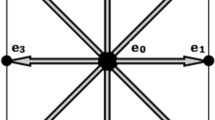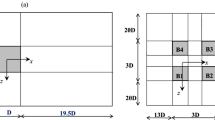Abstract
A cylinder/cluster subjected to axial flow is the most fundamental and revealing problem in the general subject of fluid-structure interaction (FSI). In this paper, the FSI of a system in which a simple cluster consisting of four cylinders is subjected to an axial flow is studied numerically with an explicit partitioned scheme. The cylinders are modeled by Euler–Bernoulli beams and the flow is solved based on Navier–Stokes equations with LES turbulence model. The effect of the dimensionless flow velocity on the dynamics of the cylinders is investigated in detail. For small dimensionless flow velocity, the initial strong vibration of the cylinder is damped and the buckling instability may occur if the dimensionless velocity is large enough.
Access provided by Autonomous University of Puebla. Download conference paper PDF
Similar content being viewed by others
Keywords
1 Introduction
When the water flows through fuel assemblies in pressurized water reactor (PWR) core, the rods, which constitute the assembly, are induced to vibrate by the fluid. This vibration is called axial flow-induced vibration and is important for the PWR safety. The amplitude of this vibration is very small, however, it would fret and wear the rods so that the radioactive material may be released (Païdoussis 2004). On the other hand, the instability may be induced (Païdoussis 2004).
The axial flow-induced vibration is essentially a fluid-structure interaction (FSI) problem and has been studied theoretically by many researchers by simplifying the FSI. The rod can be considered as a cylinder. One important parameter influencing the dynamics of the system is the dimensionless flow velocity (Païdoussis 2004), which is defined in Eq. (1). For small dimensionless flow velocity, instabilities do not occur, however, they could occur if dimensionless flow velocity is large enough (Païdoussis 2004). This is also observed by experiments (Païdoussis 1979, 2004).
In this study, we try to simulate FSI numerically for a simple cluster consisting of four cylinders in an axial flow to avoid the difficulties and defects of the theoretical analyses and experiments (Liu et al. 2012).
2 Simulation Methods and Model
The flow governing equations are arbitrary Lagrangian-Eulerian (ALE) Navier-Stokes (N-S) equations (Donea et al. 2004) and the cylinders are modeled by Euler-Bernoulli beams (Thomson 1965). The cylinders can vibrate in any transverse directions. The FSI is solved by an explicit partitioned scheme, the interested readers could refer to Liu et al. (2012) for the details. The fluid flow solver is commercial CFD software Fluent, which solves ALE N-S equations with FVM (ANSYS 2009), and the structure solver is in-house developed FEM codes solving Euler–Bernoulli beam dynamic equation.
The model is shown in Fig. 1. The cylinders all have a diameter D and length 20D. The flow is confined by a cylindrical wall which is the same long as the cylinders with diameter of 6.8284D, and is hollowed with the thickness 0.06D. For each cylinder we define radial and tangential directions R and T (Gagnon and Païdoussis 1994a, b). The cylinders are respectively clamped at their two ends and the flow is assumed turbulent and solved numerically with LES model, in which the subgrid-scale (SGS) model is Smagorinsky–Lilly model (ANSYS 2009).
3 Results and Discussion
We define the dimensionless flow velocity \( \bar{U} \), mass ratio \( \beta \), Reynolds number Re and the dimensionless time \( \tau \) (Païdoussis 2004) as
where \( \upsilon_{0} \) is the average flow inlet velocity; \( \rho \) and \( \rho_{b} \) are the density of the fluid and cylinders, respectively; \( \mu \) is the viscosity of the fluid; \( D_{h} \) is the hydraulic diameter; \( A_{t} \), \( A_{e} \) and L are the total cross sectional area, effective sectional area and length of the cylinders. We investigate two cases, in which Re = 1.05 × 105, \( \beta = 0.4699 \) but \( \bar{U}\, = \,4.4499 \), 6.0173 respectively.
The vibrations of the mid-spans of cylinders #1 and #2 for \( \bar{U} = 4.4499 \) and \( 6.0173 \) are shown in Figs. 2 and 3, where the dimensionless displacements \( d_{r} \) and \( d_{t} \) in R and T directions are defined by normalizing the displacements in these two directions with the diameter D of the cylinders. When \( \bar{U} = 4.4499 \), the cylinder #1 is initially located as the first beam shape with the maximum displacement \( 0.2D \) in its R direction and equilibrium shape in T direction, and all other cylinders have no displacement. As shown in Fig. 2, the initial strong vibration of cylinder #1 in its R direction is damped rapidly into weak oscillation with the amplitude about \( 0.01D \). At the beginning, a strong vibration of cylinder #2 in its R direction is induced but damped rapidly into weak oscillation with the amplitude about \( 0.01D \). which is similar to the case of cylinder #1. In T direction, for both cylinders #1 and #2, only weak oscillations are induced by the flow and the amplitudes are comparable to those of final vibrations in R direction. The weak oscillation could be categorized as sub-critical vibration as a result of turbulence (Païdoussis 2004). The vibrations of cylinders #3 and #4 are similar to that of cylinder #2.
If the dimensionless flow velocity is increased to \( 6.0173 \), the buckling instability is found, as shown in Fig. 3. To investigate the instability, all cylinders have no displacements in all directions at the beginning. It is very clear that the vibrations of both cylinders #1 and #2 are enhanced dramatically within a short time, e.g., the displacement of the mid-span of cylinder #1 in its R direction is increased to about \( 0.14D \). The two cylinders seem buckled but with weak oscillations around the buckled shapes, respectively. In T direction, there are only weak oscillations induced for the two cylinders, respectively. The amplitudes of the weak oscillations of the two cylinders in R direction are comparable to those in T direction and those of the final weak oscillations for \( \bar{U} = 4.4499 \). The cases for cylinders #3 and #4 are very similar to those for cylinders #1 and #2.
Thus, we could conclude that only weak vibration could be induced by the flow if the dimensionless flow velocity is small, however, the buckling instability may occur if the dimensionless flow velocity is large enough. This was also predicted by linear theoretical analysis and observed by experiment (Païdoussis 1979, 2004).
References
ANSYS Inc (2009) ANSYS FLUENT 12.0 Documentation
Donea J, Huerta A, Ponthot JP, Rodríguez-Ferran A (2004) Arbitrary lagrangian-eulerian methods. In: Stein E et al (eds) Encyclopedia Comput Mech. Wiley, Barcelona
Gagnon JO, Païdoussis MP (1994a) Fluid coupling characteristics and vibration of cylinder clusters in axial flow, part 1: theory. J Fluid Struct 8:257–291
Gagnon JO, Païdoussis MP (1994b) Fluid coupling characteristics and vibration of cylinder clusters in axial flow, part 2: experiment. J Fluid Struct 8:293–324
Liu ZG, Liu Y, Lu J (2012) Fluid-structure interaction of single flexible cylinder in axial flow. Comput Fluids 56:143–151
Païdoussis MP (1979) The dynamics of clusters of flexible cylinders in axial flow: theory and experiments. J Sound Vib 65:391–417
Païdoussis MP (2004) Fluid-structure interactions: slender structures and axial flow, vol 2. Academic Press, Netherlands
Thomson WT (1965) Vibration theory and applications. Prentice-Hall, Englewood Cliffs
Acknowledgments
Support given by the HKPolyU/AREVA collaboration fund under grant No. RPQ4 is gratefully acknowledged.
Author information
Authors and Affiliations
Corresponding author
Editor information
Editors and Affiliations
Rights and permissions
Copyright information
© 2014 Springer-Verlag Berlin Heidelberg
About this paper
Cite this paper
Liu, Z.G., Liu, Y., Lu, J. (2014). The Numerical Simulation of Fluid-Structure Interaction on a Simple Cluster in an Axial Flow. In: Zhou, Y., Liu, Y., Huang, L., Hodges, D. (eds) Fluid-Structure-Sound Interactions and Control. Lecture Notes in Mechanical Engineering. Springer, Berlin, Heidelberg. https://doi.org/10.1007/978-3-642-40371-2_57
Download citation
DOI: https://doi.org/10.1007/978-3-642-40371-2_57
Published:
Publisher Name: Springer, Berlin, Heidelberg
Print ISBN: 978-3-642-40370-5
Online ISBN: 978-3-642-40371-2
eBook Packages: EngineeringEngineering (R0)







